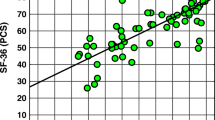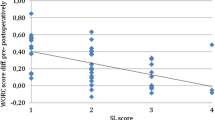Abstract
In a prospective clinical trial, first the German Short Musculoskeletal Function Assessment questionnaire (SMFA-D) was tested for reliability, validity, and responsiveness in 23 patients with rotator cuff tears, and secondly the Short Form (SF)-36, and the Constant score were evaluated comparatively in 45 patients with rotator cuff tear undergoing open repair. Retest reliability was excellent for the functional index of the SMFA-D and satisfactory for the bother index. The SMFA-D showed good validity and responsiveness. All three instruments demonstrated significantly the positive effect of rotator cuff repair at 12-month follow-up. Using comparable scales, effect sizes were bigger with the SMFA-D than with the SF-36 and as big as the Constant score. Significant correlations of the SMFA-D indices with the SF-36 scales and the Constant score could be shown preoperatively. At 12-month follow-up, all correlations between SMFA-D indices, SF-36 scales, and Constant score function scales were still significant. We recommend use of the SMFA-D to assess changes in functional status concerning patients with rotator cuff tear undergoing open repair.


Similar content being viewed by others
References
Cofield RH, Parvizi J, Hoffmeyer PJ, Lanzer WL, Ilstrup DM, Rowland CM (2001) Surgical repair of chronic rotator cuff tears. J Bone Joint Surg Am 83:71–77
Watson EM, Sonnabend DH (2002) Outcome of rotator cuff repair. J Shoulder Elbow Surg 11:201–211
Milgrom C, Schaffler M, Gilbert S, Van Holsbeck M (1995) Rotator cuff changes in asymptomatic adults. J Bone Joint Surg Br 77: 296–298
Gohlke F (1993) Ultrasonographic appearance of the rotator cuff in elderly subjects. Orthopäde 22:288–293
Constant CR (1984) Age related recovery of shoulder function after injury. Thesis, University College, Cork
Constant CR, Murley AGH (1987) A clinical method of function assessment of the shoulder. Clin Orthop 214:160–164
Richards RR, Kai-Nan An, Bilgiani LU et al (1994) A standardized method for the assessment of shoulder function. J Shoulder Elbow Surg 3:347–352
Mancuso CA, Altchek DW, Craig EV, Jones EC, Robbins L, Warren RF, Williams-Russo P (2002) Patients’ expectations of shoulder surgery. J Shoulder Elbow Surg 11:541–549
Swiontkowski MF, Buckwalter JA, Keller RB, Haralson R (1999) The outcomes movement in orthopaedic surgery: where we are and where we should go. J Bone Joint Surg Am 81:732–740
Swiontkowski MF, Engelberg R, Martin DP, Angel J (1999) Short musculoskeletal function assessment questionnaire: reliability, validity and responsiveness. J. Bone Joint Surg Am 81:1245–1260
Koenig A, Kirschner S, Walther M, Boehm D, Faller H (2000) I. Cultural adaptation, practicability and reliability evaluation of the Musculoskeletal Functional Assessment Questionnaire. Z Orthop Ihre Grenzgeb 138:295–301
Koenig A, Walther M, Matzer M, Heesen T, Kirschner S, Faller H (2000) II. Validity and sensitivity to change of the Musculoskeletal Functional Assessment Questionnaire in primary gonarthrosis and total endoprosthetic joint replacement. Z Orthop Ihre Grenzgeb 138:302–305
Kirschner S, Walther M, Boehm D, Matzer M, Heesen T, Faller H, König A (2003) German short musculoskeletal function assessment questionnaire (SMFA-D): comparison with the SF-36 and WOMAC in a prospective evaluation in patients with primary osteoarthritis undergoing total knee arthroplasty. Rheumatol Int 23:15–20
Bullinger M, Kirchberger I (1998) SF 36 Fragebogen zum Gesundheitszustand. Hohgrefe, Göttingen
Conboy VB, Morris RW, Kiss J, Carr AJ (1996) An evaluation of the Constant-Murley Shoulder Assessment. J Bone Joint Surg Br 78: 229–232
Gerber C (1996) Use of Constant Score for assessing shoulder instability. Instructional course, 9th Congress of the SECEC/ESSES, Nottingham
Boehm TD, Mueller T, Rehwald C, Gohlke F, Barthel T, Eulert J (1997) Age and sex related Constant Murely Score. J Shoulder and Elbow Surg 6:194
Boehm TD (2002) Schulter scoring. In: Gohlke F, Hedtmann A (eds) Die Schulter. Thieme, Berlin, pp 90–94
Ahrens W, Bellach BM, Joeckel KH (1998) Messung soziodemographischer Merkmale in der Epidemiologie. Medizin Verlag, Munich
Kazis LE, Anderson JJ, Meenan RF (1989) Effect sizes for interpreting changes in health status. Med Care 27 [Suppl 3]:178–189
Wright JG, Young NL (1997) A comparison of different indices of responsiveness. J Clin Epidemiol 50:239–246
Cohen J (1992) A power primer. Psychol Bull 112:155–159
Beaton DE, Richards RR (1996) Measuring function of the shoulder. A cross-sectional comparison of five questionnaires. J Bone Joint Surg Am 78:882–890
McKee, Yoo DJ (2000) The effect of surgery for rotator cuff disease on general health status. J Bone Joint Surg Am 82:970–979
Dawson J, Hill G, Fitzpatrick R, Carr A (2002) Comparison of clinical and patient-based measures to assess medium-term outcomes following shoulder surgery for disorders of the rotator cuff. Arthritis Rheum 47:513–519
Gartsman GM, Brinker MR, Khan M, Karahan M (1998) Self-assessment of general health status in patients with five common shoulder conditions. J Shoulder Elbow Surg 7:228–237
Gazielly DF, Gleyze P, Montagnon C (1994) Functional and anatomical results after rotator cuff repair. Clin Orthop 304:43–53
Plafki C, Hedtmann A, Fett H, Lutke A, Willburger RE (1997) Results of surgical therapy of ruptures of the rotator cuff of the shoulder. Z Orthop Ihre Grenzgeb 135:360–367
Knudsen HB, Gelineck J, Sojbjerg JO, Olsen BS, Johannsen HV, Sneppen O (1999) Functional and magnetic resonance imaging evaluation after single-tendon rotator cuff reconstruction. J Shoulder Elbow Surg 8:242–246
Machner A, Pap G, Mohrenweiser L, Merk H, Neumann HW (2001) Comparison of two surgical techniques in isolated supraspinatus rupture. A matched-pair study. Unfallchirurg 104:19–24
Hollinshead RM, Mohtadi NG, Van de Guchte RA, Wadey VM (2000) Two 6-year follow-up studies of large and massive rotator cuff tears: comparison of outcome measures. J Shoulder Elbow Surg 9:373–381
Kirschner S, Walther M, Boehm D, Wollmerstedt N, Koenig, Faller H (2003) Unterschiede im Rehabilitationsverlauf nach totalendoprothetischem Ersatz von Hüft- und Kniegelenk mit dem SMFA-D und dem SF-36. DRV Sonderausgabe 40:346–348
Acknowledgement
The authors would like to thank Jochen Schneider for collection of the questionnaires. The SMFA-D questionnaire and its clinical results are available online for download at http://www.smfa-d.de.
Author information
Authors and Affiliations
Corresponding author
Additional information
This study is a project of the Rehabilitation Research Network of Bavaria funded by the German Ministry of Education and Research and the German Statutory Pension Insurance (http://www.smfa-d.de).
Rights and permissions
About this article
Cite this article
Böhm, T.D., Kirschner, S., Köhler, M. et al. The German Short Musculoskeletal Function Assessment questionnaire: reliability, validity, responsiveness, and comparison with the Short Form 36 and Constant score—a prospective evaluation of patients undergoing repair for rotator cuff tear. Rheumatol Int 25, 86–93 (2005). https://doi.org/10.1007/s00296-003-0423-z
Published:
Issue Date:
DOI: https://doi.org/10.1007/s00296-003-0423-z




